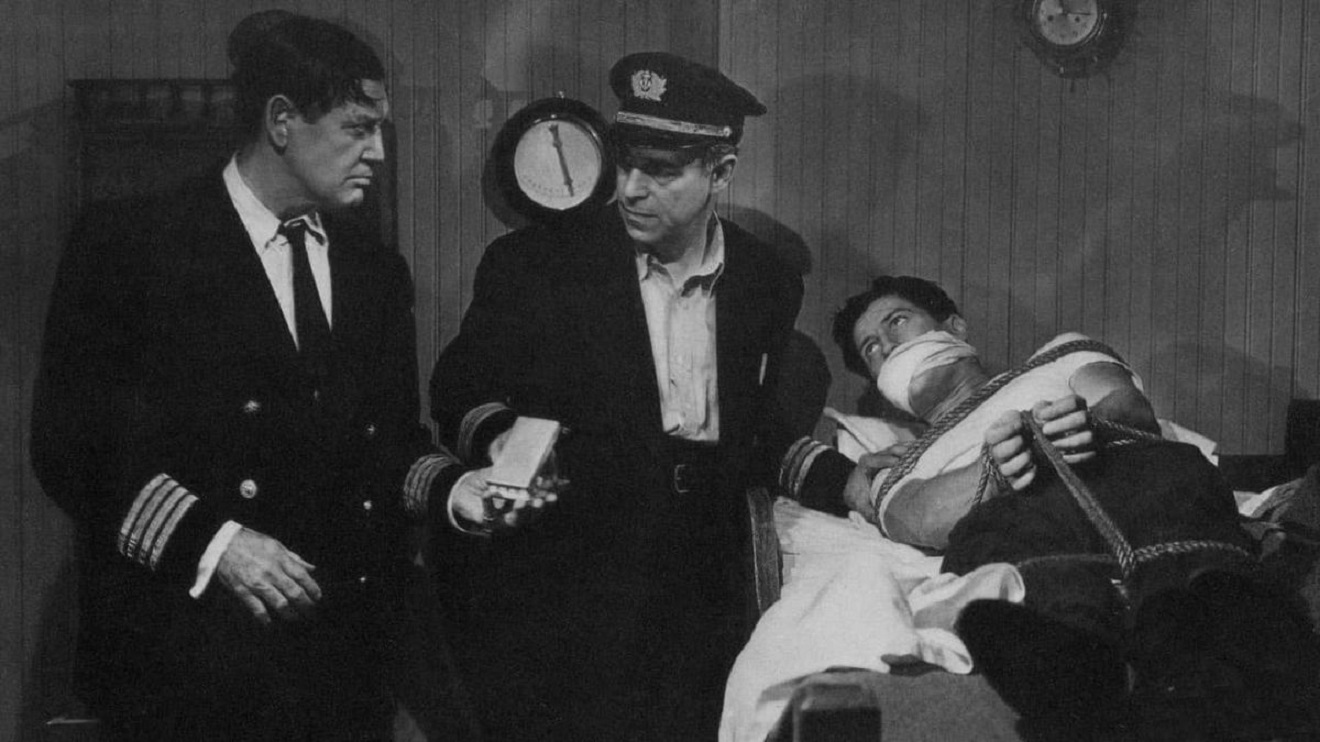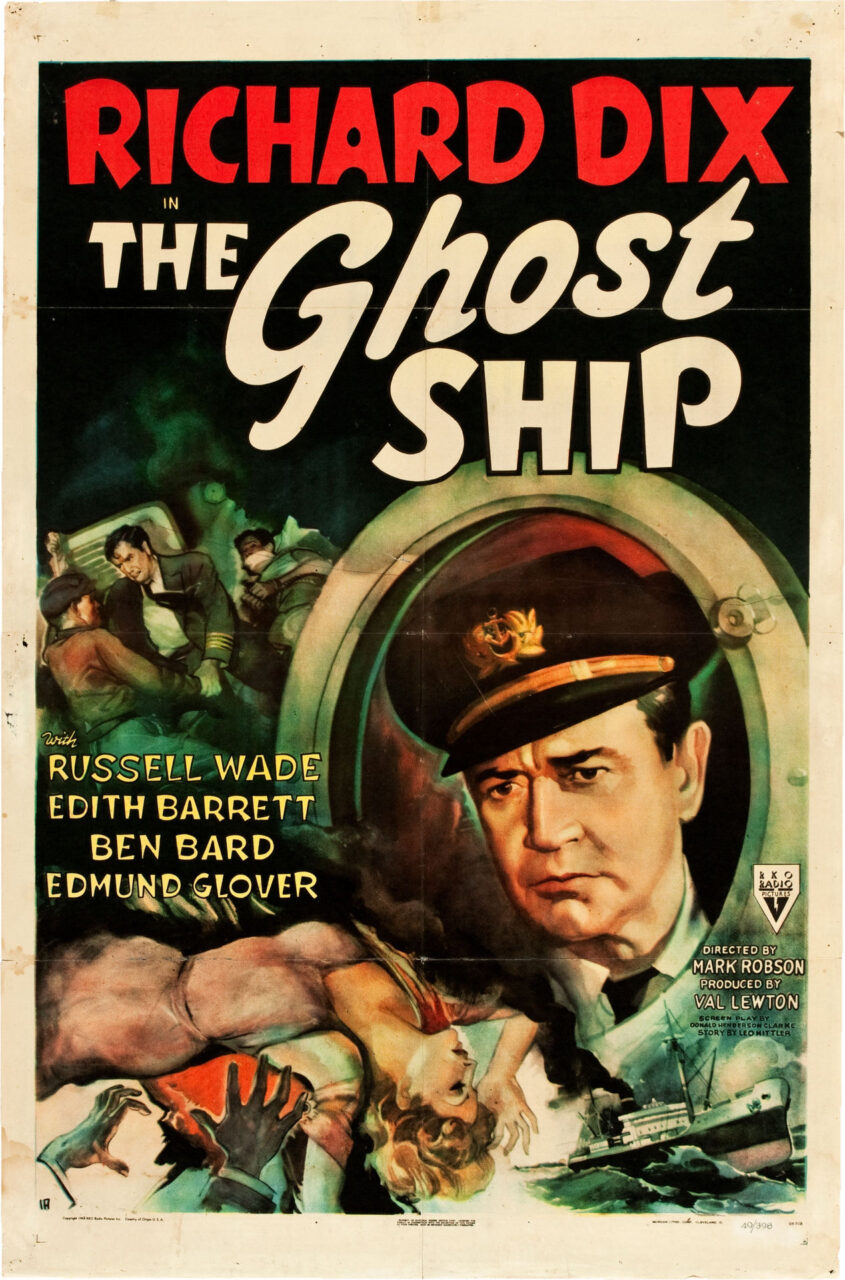USA. 1943.
Crew
Director – Mark Robson, Screenplay – Donald Henderson Clarke, Story – Leo Mittler, Producer – Val Lewton, Photography (b&w) – Nicholas Musuraca, Music – Roy Webb, Music Director – C. Bakaleinikoff, Special Effects – Vernon L. Walker, Art Direction – Albert S. D’Agostino & Walter E. Keller. Production Company – RKO Radio Pictures.
Cast
Russell Wade (Tom Merriam), Richard Dix (Captain Will Stone), Edith Barrett (Ellen Roberts), Edmund Glover (Jacob ‘Sparks’ Winslow), Ben Bard (Bowns), Skelton Knaggs (Finn), Boyd Davis (Charles Roberts)
Plot
Tom Merriam signs on as third mate aboard The Altair under Captain Will Stone. Stone talks much about absolute authority and how he expects total obedience from his crew. Tom suspects that Stone deliberately locked a man who stood up to him in the anchor locker to be crushed under the massive anchor chain. Back in port, Tom goes to the company agent and makes a complaint against Stone, accusing him of murder but the company dismisses the charge. Tom decides to quit The Altair but is knocked unconscious in a barroom brawl. He comes around to find himself back aboard The Altair out at sea again. Stone informs him that he is now a guest aboard. Tom realises that Stone is preparing to kill him and that the crew are so loyal to Stone that none will come to his aid.
The Ghost Ship is one of the horror films from legendary producer Val Lewton. Lewton, a Russian immigrant, gained fame in the 1940s at RKO Radio Pictures. His first film was the classic Cat People (1942), which patented the style that Lewton became associated with. There Lewton created a form of psychological rather than overt horror where any supernatural menace always existed in a state of ambiguity, hovering between whether it was physically real or something that only existed in the minds of the protagonists. Audiences were never given any clear glimpses of the menace so we could not be sure either. Throughout his brief career, Val Lewton made a number of these psychologically ambiguous genre films with I Walked With a Zombie (1943), The Leopard Man (1943), The Seventh Victim (1943), The Curse of the Cat People (1944), Isle of the Dead (1945), The Body Snatcher (1945) and Bedlam (1946). All of these are classics that are well above average and highly recommended.
The Ghost Ship is the most obscure among Val Lewton’s films. All of Lewton’s other films have been readily available in video/dvd release and screen regularly on tv with the exception of The Ghost Ship. The reason for this is that upon the film’s release, two writers sued Lewton and RKO claiming that he had plagiarised the script from a work they had submitted to the studio. Lewton denied this but lost the case. Subsequently, The Ghost Ship was withdrawn from circulation. It is widely reported by some websites that it was unavailable for viewing until 1993, although this is not true and the film has circulated (albeit obscurely).
The film comes with an incredibly haunted and melancholic tone. Director Mark Robson sets the scene with an extremely spooky opening as Russell Wade comes across a blind man singing a song where the man is able to predict everything that Wade is about to do, before Wade boards the ship and meet a mute (an uncredited Skelton Knaggs) and we suddenly move into the mute’s whispered voiceover: “This is another man I can never know … Because I am a mute and cannot speak. I am cut off from other men but in my own silence I can hear things they cannot hear, know things they cannot know.”
Throughout, there is a constant sense of something sinister lurking in the shadows – the captain’s opening speech to the crew where a light is suddenly swung around to reveal a man’s dead body has been hidden in the shadows beside them the whole time; the scenes with the crew trying to catch a giant swinging brace whose presence is denoted mostly by its massive shadow; the crewman being crushed by an anchor chain after being locked in the locker by the captain (a scene where we cannot be sure that Richard Dix’s captain did not do it accidentally or it was a deliberate action as Russell Wade accuses).

The Ghost Ship was the first of Val Lewton’s horror films to feature a mundane as opposed to a supernatural premise. Lewton’s classic psychological ambiguity is still there with the crucial issue that the film hangs on now having become one of the captain’s intent. Mark Robson draws the suspense out with incredible tension. There is an excellent scene when Russell Wade finds that the lock on his cabin door has been removed and tries to settle in for the night, rigging up a cord that will turn on the lamp if it is opened; where he then turns the lights out to go to bed, only for the rocking of the ship to smash a plate in the darkness startling him and causing the door to swing open and set the lamp off. It is a marvellous piece of psychological suggestion.
The scenes with Russell Wade trapped aboard the ship where he realises that the captain is going to kill him and trying to enlist the crew’s help have beautifully stark atmosphere, none the more so than when Wade tries to pick up a lynch pin to defend himself and the captain’s hand comes up from behind and stops him, gently saying: “Since you have no earthly use of this.” There is also a great climactic knife fight.
Most of Val Lewton’s films were made on economy budgets. Lewton was often handed a title or concept by RKO and told to turn it into a film. The Ghost Ship was a case where he was given the sets for a ship used in the ocean-going drama Pacific Liner (1938) and told to make a film around it. Even so, the film is mostly contained to a few deck sets and some weak back-projected ocean footage with no actual shots that take place at sea. The most noticeable thing about The Ghost Ship – clearly a title that was handed to Lewton – is that there are no ghosts in the film despite the title. Later this is semi-justified in a metaphor given by Edith Barrett, which likens Richard Dix’s captaincy to something that in its autocracy has created a ‘ghost ship’.
The Ghost Ship is discussed in the documentary Val Lewton: The Man in the Shadows (2007). The Ghost Ship is unrelated to several other films with the same title including the British ghost story Ghost Ship (1952), the children’s film Ghost Ship (1992) and the supernatural horror film Ghost Ship (2002).
Mark Robson started as an editor and began directing under Val Lewton, where he also made The Seventh Victim (1943), Isle of the Dead (1945) and Bedlam (1946). Robson later went onto make other films such as The Bridges at Toko-Ri (1954), Peyton Place (1957), The Inn of the Sixth Happiness (1958), Von Ryan’s Express (1965), Valley of the Dolls (1967), the psycho-thriller Daddy’s Gone A-Hunting (1969), the Kurt Vonnegut adaptation Happy Birthday, Wanda June (1971) and the disaster movie Earthquake (1974).
Clip from the film here


